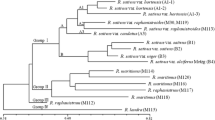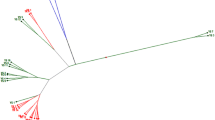Abstract
Patterns of phenotypic and phenetic variability in sixPortuguese cultivars of chestnut (Castanea sativa Mill.) are evaluated. Morphological characterisationwas based on the quantification of seventeen traits. Varianceanalysis showed significant differences among cultivars, and cultivar× year for all the traits studied, and trees within cultivarsshowed also some significant differences for some of themorphological variables. A significant correlation was obtainedbetween length of the leaf blade and the percentage of unisexual andandrogynic inflorescence with the effective thermal index,accumulated rainfall from April to October and from July to October,or the accumulated temperature below seven during the dormant period.Principal Component and cluster analysis were performed to group thecultivars, according to their similarity coefficients. For molecularcharacterisation, 125 RAPD and 157 ISSR polymorphic markers wereamplified using 28 and 7 primers respectively. High level ofcongruence among the two marker systems (r =90.5%) was obtained from comparison of pheneticsimilarities based on the percentage of shared fragments. ISSRmarkers revealed important advantages over RAPDs, due to a higheffective multiplex ratio (12.5 for ISSR compared with 2.2 forRAPD analysis) and reproducibility. Although morphological andmolecular results are comparable, slight differences are showed incluster analysis UPGMA dendrograms. Molecular analysis explainedhomonym situations among 'Martainha' and'Longal' cultivars in Portugal.
Similar content being viewed by others
References
Bassam B.J., Anollés-Caetano G. and Gresshoff P.M. 1991. Fast and sensitive silver staining of DNA in polyacrylamide gels. Anal. Biochem. 196: 80–83.
Botta R., Akkak A., Marinoni D., Bounous G., Kampfer S., Steinkellner H. et al. 1999. Evaluation of microsatellite markers for characterizing chestnut cultivars. Acta Horticulturae 494: 277–280.
Bowers J.E. and Meredith C.P. 1998. Comparison of RFLP, AFLP and SSR markers for analysing phenetic relationships among cultivars of Vitis vinifera. In: San Diego, USA, Proceedings of the Plant and Animal V Conference. 12-16 January.
Doyle J.J. and Doyle J.L. 1990. Isolation of plants DNA from fresh tissue. Focus 12: 13–15.
Fang D.Q., Roose M.L., Krueger R.R. and Federici C.T. 1997. Fingerprinting trifoliate orange germplasm accessions with isozymes, RFLPs and inter-simple sequence repeat markers. Theor. Appl. Genet. 95: 211–219.
Fineschi S., Taurchini D., Muller-Stark G. and Conedera M. 1993. Genetic characterization of cultivated varieties of European chestnut (Castanea sativa Mill) in southern Switzerland III. Analysis of RAPDs molecular markers.Proceedings of the International Congress on Chestnut. October 20-23., pp. 309–313.
Galderisi U., Cipollaro M., Di Bernardo L., De Masi G., Galano G. and Cascino A. 1998. Molecular typing of Italian sweet chestnut cultivars by random amplified polymorphic DNA analysis. J. Hortic. Sci. Biotech. 73: 259–263.
INE 1997. Estatísticas Agrícolas. Lisboa.
Lanham P.G. and Brennan R.M. 1999. Genetic characterisation of gooseberry (Ribes grossularia subgenus Grossularia) germ-plasm using RAPD, ISSR and AFLP markers. J. Hortic. Sci. Biotech. 74: 361–366.
Monte-Corvo L., Cabrita L., Oliveira C.M. and Leitão J.M. 2000. Assessment of genetic relationships among Pyrus species and cultivars using AFLP and RAPD markers. Gen. Res. Crop Evol. 7: 257–265.
Nei M. and Li W.H. 1979. Mathematical model for studying genetic variation in terms of restriction endonucleases. Proc. Natl. Acad. Sci., USA 76: 5269–5273.
Oraguzie N.C., McNeil D.L., Klinac D.J., Knowles R.D. and Sedcole J.R. 1998. Relationships of chestnut species and New Zealand chestnut selections using morpho-nut characters. Euphytica 99: 27–33.
Pereira M.J., Castro L.F., Torres-Pereira J.M. and Lorenzo S.P. 1999. Isozyme polymorphisms in Portuguese chestnut cultivars. Acta Horticulturae 494: 283–286.
Pereira-Lorenzo S., Fernández-López J. and Moreno-González J. 1996a. Variability and grouping of Northwestern Spanish chestnut cultivars. I. Morphological traits. J. Am. Soc. Hort. Sci. 121: 183–189.
Pereira-Lorenzo S., Fernández-López J. and Moreno-González J. 1996b. Variability and grouping of Northwestern Spanish chestnut cultivars. II. Isoenzymatic traits. J. Am. Soc. Hort. Sci. 121: 190–187.
Petersen G. and Seberg O. 1998. Molecules vs. morphology. In: Karp A., Isaac P.G. and Ingram D.S. (eds), Molecular Tools for Screening Biodiversity. Chapman and Hall, London, pp. 359–364.
Powell W., Morgante M., Andre C., Hanafrey M., Vogel J.M., Tingey S.V. et al. 1996. The comparison of RFLP, RAPD, AFLP and SSR (microsatellite) markers for germplasm analysis. Mol. Breeding 2: 225–238.
Rafalski A., Vogel J.M., Morgante M., Powell W., Andre C. and Tingey S.V. 1996. Generating and using DNA markers in plants. In: Birren B. and Lai E. (eds), Nonmammalian Genomic Analysis. Academic Press, San Diego, USA, pp. 75–134.
Rohlf F.J. 1993. NTSYS-PC Numerical Taxonomy and Multivariate Analysis System. Exeter Publications, Setauket, New York.
Sambrook J., Fritsch E.F. and Maniatis T. 1989. Molecular Cloning: A Laboratory Manual. Cold Spring Habor, New York.
Santana C., Valdiviesso T. and Oliveira C.M. 1999. Molecular typing of rootstock hybrids (Castanea sativa 3 Castanea crenata) and Portuguese Castanea sativa cultivars based on RAPD markers. Acta Horticulturae 494: 295–301.
Sedgley M. and Griffin A.R. 1989. Sexual Reproduction of Tree Crops. Academic Press, London.
Villani F., Lauteri M., Sansotta A., Cherubini M., Monteverdi M.C., Mattioni C. et al. 1999. Genetic structure and quantitative traits variation in F1 full-sibs progenies of Castanea sativa Mill. Acta Horticulturae 494: 395–405.
Villani F., Pigliucci M., Lauteri M. and Cherubini M. 1992. Congruence between genetic, morphometric and physiological data on differentiation of Turkish chestnut (Castanea sativa). Genome 35: 251–256.
Welsh J.M. and McClelland M. 1990. Fingerprinting genomes using PCR with arbitrary primers. Nucleic Acids Res. 18: 7213–7218.
Williams J.G.K., Kubelik A.R., Kenneth J., Rafalski J.A. and Tingey S.V. 1990. DNA polymorphisms amplified by arbitrary primers are useful as genetic markers. Nucleic Acids Res. 18: 6531–6535.
Yang W., Oliveira A.C., Godwin I., Schertz K. and Bennetzen J.L. 1996. Comparison of DNA marker technologies in characterizing plant genome diversity: variability in Chinese sorghums. Crop Sci. 36: 1669–1676.
Zietkiewicz E., Rafalski A. and Labuda D.1994. Genome fingerprinting by simple sequence repeat (SSR)-anchored polymerase chain reaction amplification. Genomics 20: 176–183.
Author information
Authors and Affiliations
Rights and permissions
About this article
Cite this article
Goulão, L., Valdiviesso, T., Santana, C. et al. Comparison between phenetic characterisation using RAPD and ISSR markers and phenotypic data of cultivated chestnut (Castanea sativa Mill.). Genetic Resources and Crop Evolution 48, 329–338 (2001). https://doi.org/10.1023/A:1012053731052
Issue Date:
DOI: https://doi.org/10.1023/A:1012053731052




